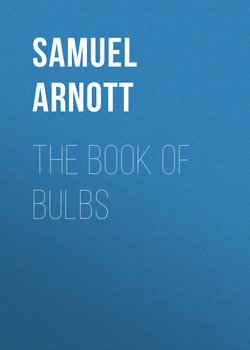Читать книгу The Book of Bulbs - Arnott Samuel - Страница 6
CHAPTER IV
HARDY BULBS
ОглавлениеCalochorti and Cyclobothras – Camassias – Colchicums – Convallarias – Forcing Lily of the Valley – Corydalises – Crinums – Crocosmias and Montbretias – Crocuses
Calochorti and Cyclobothras
The Calochortus, with which is now included the Cyclobothra, is one of our most beautiful bulbous plants, its appearance well justifying the names of Butterfly Tulip or Star Tulip applied to it. With a little protection in the way of rough litter, it will thrive outside in mild districts, but those who have any fear for the safety of their bulbs can grow these flowers in frames. They like a raised bed of light, dry soil in which they may be planted in September or October three inches deep, and protected with dry straw or spruce branches. When danger from severe frost is over, this may be removed and plenty of water given. If grown in frames, the lights may be removed at that time. There are now many species and varieties in cultivation, but the following form a good selection for those who wish to begin their cultivation: – albus, pulchellus, cæruleus major (these like a soil largely of leaf-mould, in half-shade), Purdyi, luteus, splendens, and any of the venustus varieties, especially those of the "Eldorado" strain. After the leaves die down, the bulbs should either be lifted and dried, or covered with a frame.
Camassias
The Camassias, or Quamashes, are handsome plants with long leaves and tall spikes of flowers of much beauty, although rather fugacious. The blooms are generally blue, but there is a white variety of the pretty C. esculenta and a creamy-white one called Leichtlinii. Fraseri is very pretty, and Cusickii and Engelmanni are also worth growing. They like a rather moist, peaty soil and a little shade when they bloom in May or June.
Colchicums
Colchicums or Meadow Saffrons are of much value in the garden in autumn, and in large clumps or masses produce a splendid effect. The few spring species are of less merit and are only desirable for those who like collections of uncommon flowers. They like a rather rich soil, and a sunny position. As the leaves appear in spring, the Colchicums should be grown through grass or other herbage where the flowers can have some support. The best time for planting is immediately after the leaves become yellow. The tops of the corms or bulbs should be about three inches below the surface. Colchicums are very poisonous and must not be planted where there can be any danger of their being eaten for edible tubers. The finest in cultivation are Bornmulleri, Sibthorpii, and speciosum, in several forms, including maximum, rubrum, and the new white album. Byzantinum is a good species, and some of the double forms, ascribed to autumnale, are possibly varieties of this. These double varieties are very useful, the best being album fl. pl., roseum fl. pl., and striatum fl. pl. The ordinary autumnale, of which there are several colours from white to purple, is rather weak in the flower-tubes and is much injured by bad weather. Other good Meadow Saffrons are cilicicum, Bertoloni, Decaisnei, alpinum, variegatum, Bivoniæ, and montanum. The spring-blooming crociflorum, with white flowers lined with violet, is small and much affected by slugs. The new hydrophyllum, which likes a damp spot, is a neat little spring species; luteum, also blooming in spring, does not appear to be so hardy as any of the others.
Convallarias
The cultivation of the Lily of the Valley out of doors calls for no special remarks beyond saying that it likes shade and some moisture. It is also desirable to mention that there are varieties with pink flowers; with double white flowers; and with gold-striped leaves. The first of these shows its colouring much better outside than when grown under glass. Fortin's variety and prolificans are specially good forms.
Forcing Lily of the Valley
Lily of the Valley is easily forced, and this can be done either by lifting large clumps or purchasing crowns, and growing them in a hot-bed or by planting them in pans or pots. The crowns should be kept above the soil, and they ought to be kept moist and dark until they have made some growth, when light should be given. For early bloom at Christmas, the crowns ought to be potted in the beginning or middle of November. A temperature of from 65 to 70 degrees is suitable for forcing this favourite flower. Retarded crowns are coming into favour, and give good results with careful treatment. It is inadvisable to put these in heat at first.
